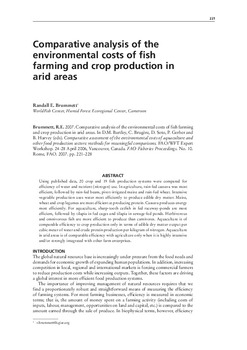Comparative analysis of the environmental costs of fish farming and crop production in arid areas

Citation
Brummett, R.E. (2007). Comparative analysis of the environmental costs of fish farming and crop production in arid areas. p. 221-228. In: D.M. Bartley, C. Brugère, D. Soto, P. Gerber and B. Harvey (eds.) Comparative assessment of the environmental costs of aquaculture and other food production sectors: methods for meaningful comparisons. FAO/WFT Expert Workshop. 24-28 Apr 2006, Vancouver (Canada). FAO Fisheries Proceedings. No. 10. Rome, FAO..
Using published data, 20 crop and 19 fish production systems were compared for efficiency of water and nutrient (nitrogen) use. In agriculture, rain-fed cassava was most efficient, followed by rain-fed beans, pivot-irrigated maize and rain-fed wheat. Intensive vegetable production uses water most efficiently to produce edible dry matter. Maize, wheat and crop legumes are most efficient at producing protein. Cassava produces energy most efficiently. For aquaculture, sharp-tooth catfish in fed raceway-ponds are most efficient, followed by tilapia in fed cages and tilapia in sewage-fed ponds. Herbivorous and omnivorous fish are more efficient to produce than carnivores. Aquaculture is of comparable efficiency to crop production only in terms of edible dry matter output per cubic meter of water and crude protein production per kilogram of nitrogen. Aquaculture in arid areas is of comparable efficiency with agriculture only when it is highly intensive and/or strongly integrated with other farm enterprises.
Permalink
Date Available
Type
Research Themes
Language